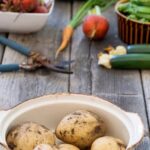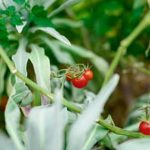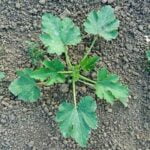As the vibrant colors of summer begin to fade, the allure of fall vegetable container gardens takes center stage. Growing vegetables in containers during the autumn season not only adds beauty to your outdoor space but also provides a bountiful harvest. Fall gardening offers a variety of benefits, including prolonged growing seasons and protection from early frosts. Additionally, container gardening has gained popularity due to its versatility and ability to fit even in limited spaces.
The beauty of fall vegetable container gardens lies in their ability to add a touch of nature’s bounty during a time when most plants are winding down. The sight of lush green leaves, vibrant orange pumpkins, and plump red tomatoes nestled in containers is a delight for any gardener. With careful planning and proper care, these gardens can yield an impressive array of fresh produce well into the cooler months.
While the aesthetic appeal is undeniable, fall gardening brings numerous practical advantages as well. By planting vegetables in containers, you can extend your harvest season since containers can easily be moved indoors if temperatures drop too low. This allows you to enjoy fresh homegrown vegetables long after traditional garden beds have succumbed to frost. Furthermore, container gardens provide greater control over soil quality and drainage, resulting in healthier plants with higher yields.
Container gardening has revolutionized the way people grow their own food. It has become an increasingly popular option due to its flexibility and suitability for various living situations. Whether you have a small patio or an expansive backyard, container gardening empowers anyone with a green thumb – regardless of space constraints or limitations – to reap the rewards of homegrown produce. Fall vegetable container gardens exemplify this versatility by allowing gardeners to cultivate crops even as summer transitions into autumn.
In summary, fall vegetable container gardens offer both visual appeal and an abundance of fresh produce. Through careful planning and attention to detail, these gardens can thrive even as temperatures dip.
In the following sections, we will explore the best vegetable varieties for fall container gardening, discuss container selection and preparation, offer tips for soil preparation and fertilization, guide you through essential planting techniques, provide advice on watering and maintenance, share methods for extending the growing season, and give tips on harvesting and enjoying the fall bounty. So get ready to embark on a rewarding seasonal undertaking with your very own fall vegetable container garden.
Best Vegetable Varieties for Fall Container Gardening
Fall is a wonderful time to start a vegetable container garden, and choosing the right vegetable varieties is crucial for success. When selecting vegetables for fall container gardening, it’s important to consider their ability to thrive in cooler temperatures and limited space. Here are some of the best vegetable varieties that are well-suited for container gardens during the fall season.
One popular choice for fall container gardening is kale. Kale is a cold-hardy green leafy vegetable that actually tastes sweeter after exposure to frost. It comes in different varieties such as curly kale and dinosaur kale, each offering unique flavors and textures. Carrots also make an excellent addition to fall containers, as their root development improves in cooler weather. Choose shorter carrot varieties like ‘Little Finger’ or ‘Nantes’ that are more suitable for container growth.
Spinach is another versatile vegetable that can be grown successfully in containers during the fall. Look for compact varieties such as ‘Baby Leaf’ or ‘Bloomsdale’ which have a short maturity time and require less space than traditional spinach plants. Lastly, radishes are quick-growing vegetables that can be harvested within 30 days. Varieties like ‘Cherry Belle’ or ‘Easter Egg’ radishes are perfect for container gardening due to their small size and colorful range.
When growing these vegetables in containers, keep in mind their specific characteristics and requirements. Most of them prefer well-draining soil with good moisture retention, so make sure your containers have proper drainage holes at the bottom. Additionally, pay attention to their sunlight requirements – while most vegetables need at least 6 hours of direct sunlight per day, some can tolerate partial shade.
By choosing the right vegetable varieties for your fall container garden, you can ensure a successful and productive harvest. These selected vegetables not only thrive in cooler temperatures but also provide an array of flavors and textures to enhance your meals throughout the fall season.
Container Selection and Preparation
When it comes to fall vegetable container gardening, selecting the right containers is crucial for the success of your plants. The type and size of containers can greatly affect the growth and development of your vegetables. It is important to choose containers with proper drainage, adequate space for root growth, and suitable materials.
There are various container options available for fall vegetable gardening. Pots are a popular choice because they are versatile and easy to move around if needed. Raised beds provide ample growing space and better soil drainage. Hanging baskets are ideal for small spaces or when you want to add vertical interest to your garden.
Properly preparing your containers before planting is also essential. The first step is ensuring that your containers have sufficient drainage holes at the bottom to prevent waterlogging, which can lead to root rot. If your chosen container does not have drainage holes, you can drill them yourself or consider using a layer of pebbles at the bottom to improve drainage.
The selection of soil for your fall vegetable container garden is important as well. It is recommended to use a high-quality potting mix with good water retention capabilities and adequate nutrient content. Avoid using garden soil, as it may contain pests, diseases, or weed seeds.
| Container Type | Pros | Cons |
|---|---|---|
| Pots | Versatile, portable | May require more frequent watering |
| Raised Beds | Ample growing space, better drainage | May require more initial effort for setup |
| Hanging Baskets | Saves space, adds vertical interest | May require more frequent watering |
Taking the time to carefully select and prepare your containers will ensure a healthy environment for your fall vegetables to thrive. With the right containers and proper preparation, you’re one step closer to enjoying a bountiful harvest of fresh, homegrown vegetables this fall season.
Soil Preparation and Fertilization
Proper soil preparation and fertilization are crucial for the success of fall vegetable container gardens. By taking the time to prepare and enrich the soil, gardeners can provide their plants with the essential nutrients they need to thrive. Here are some tips on how to prepare your soil and ensure your plants receive the necessary nutrition:
- Soil Testing: Before you begin planting, it’s important to test your soil’s pH level and nutrient content. This will help you determine if any amendments or fertilizers are needed. You can purchase a soil testing kit from a local garden center or send a sample to a laboratory for more accurate results.
- Organic Compost and Vermicompost: Adding compost to your container soil is an excellent way to improve its structure, fertility, and water-holding capacity. Organic compost contains rich organic matter that releases nutrients slowly over time, providing a steady supply of food for your plants. Vermicompost, also known as worm compost, is another fantastic option that adds beneficial microbes to the soil.
- Balanced Organic Fertilizers: While compost alone may not provide all the necessary nutrients for your plants, there are plenty of balanced organic fertilizer options available in stores or online. Look for fertilizers that have equal ratios of nitrogen (N), phosphorus (P), and potassium (K) – indicated by numbers such as 5-5-5 or 10-10-These nutrients play important roles in plant growth, root development, flowering, and fruit production.
Remember to follow the instructions on the fertilizer package carefully when applying it to your containers. Over-fertilizing can be harmful to plants, so it’s essential not to exceed the recommended application rates.
Preparing your soil properly and providing adequate fertilization will contribute to strong plant growth and productive fall vegetable container gardens. Healthy plants are better equipped to withstand environmental stresses, ward off diseases and pests, and produce a bountiful harvest. So, take the time to nurture your soil, and you’ll be rewarded with thriving vegetables in your containers this fall season.
Essential Tips for Planting Fall Vegetables in Containers
Planting fall vegetables in containers requires some specific considerations and techniques to ensure successful growth and bountiful harvests. Here are some essential tips to keep in mind when planting your fall vegetable container garden:
Proper Spacing
When planting vegetables in containers, it’s important to provide enough space for each plant to grow. Follow the recommended spacing guidelines provided on the seed packet or plant label. Overcrowding can lead to poor air circulation, increased pest and disease issues, and stunted growth.
Companion Planting
Take advantage of companion planting techniques to maximize productivity and deter pests naturally. Planting compatible vegetable varieties together can help improve nutrient uptake, control pests, and enhance flavors. For example, pairing carrots with onions helps repel carrot flies, while planting lettuces with herbs like dill can discourage aphids.
Vertical Gardening
Make use of vertical space in your container garden by incorporating trellises or stakes. Vining vegetables like peas, cucumbers, and beans can be trained to grow upward, saving valuable ground space. Not only does vertical gardening maximize productivity, but it also makes harvesting easier and reduces the risk of soil-borne diseases.
Transplanting Seedlings
If you’re starting your fall vegetable garden from transplants rather than seeds, take care when transplanting them into containers. Ensure the seedlings have well-established root systems before moving them from nursery pots into larger containers. Handle the delicate roots gently during transplantation to avoid damage.
Direct Seeding
For certain vegetables that tolerate cooler temperatures well (like lettuce or radishes), you can sow seeds directly into your containers. Follow the recommended planting depth and spacing instructions provided on the seed packet. Cover the seeds lightly with soil and keep them consistently moist until they germinate.
By following these essential tips for planting fall vegetables in containers, you can create a thriving and productive garden. Remember to monitor your plants regularly, provide adequate water and nutrients, and make adjustments as needed to ensure optimal growth and harvests.
Watering and Maintenance for Fall Container Gardens
Fall Vegetable Container Gardens must be properly cared for in order to thrive and produce a bountiful harvest. This section will focus on the essential aspects of watering and maintenance for fall container gardens.
Proper Watering Techniques
Watering is crucial for the success of any container garden, especially during the fall season when the weather tends to be cooler and dryer. It is important to establish a consistent watering schedule to ensure that plants receive adequate moisture. In general, it is better to water deeply and less frequently rather than shallowly and frequently. Deep watering encourages plants to develop strong roots that can sustain them throughout the season.
One helpful tip is to check the moisture level of the soil before watering. Stick your finger about an inch into the soil, and if it feels dry at that depth, it’s time to water. When watering, pour water slowly at the base of each plant until you see it flowing freely from the drainage holes at the bottom of the container. This ensures that water reaches the root zone where it is needed most.
Maintenance Tips for Fall Container Gardens
In addition to proper watering, maintenance tasks are essential for keeping fall vegetable container gardens healthy and productive.
- Fertilizing: Regular fertilization is key in providing essential nutrients for plant growth and development. Organic options such as compost or vermicompost are highly recommended as they enrich the soil with beneficial microorganisms and nutrients over time. Balancing organic fertilizers can also be used according to package instructions.
- Pruning: Occasionally pruning your plants helps maintain their shape and promotes better air circulation, which can reduce disease incidences. Remove any dead or diseased leaves gently using clean scissors or pruners, disinfecting them between plants to avoid spreading diseases.
- Pest and Disease Management: Fall gardening may also require vigilance in pest control. Monitor your plants regularly for signs of pests such as aphids or caterpillars and be prepared to address them with organic pest control methods. Additionally, keep an eye out for any signs of disease, such as powdery mildew or fungal infections, and take appropriate measures to prevent their spread.
By following these watering and maintenance tips, you can ensure that your fall vegetable container garden stays healthy and productive throughout the season. With proper care, you will be rewarded with a bountiful harvest of delicious fall vegetables to enjoy.
Season Extension Techniques
As the temperatures start to drop during the fall season, many gardeners are eager to extend their growing season and continue harvesting fresh vegetables. Season extension techniques can help protect plants from frost and temperature fluctuations, allowing for an extended harvest well into the colder months.
One effective method for extending the fall growing season in container gardens is the use of row covers. Row covers are lightweight, breathable fabrics that can be draped over plants to provide protection from cold temperatures while still allowing sunlight and water to reach the plants. These covers create a mini greenhouse effect by trapping heat around the plants and preventing frost damage. They are especially useful for cool-season crops like lettuces, kale, and carrots.
Another popular technique for season extension in containers is using cloches. Cloches are individual protective coverings or small greenhouses that can be placed over individual containers or specific plants. They come in various materials, such as glass, plastic, or even recycled items like plastic bottles or milk jugs with the tops cut off. Cloches create a microclimate around each plant and can provide protection from cold weather while also promoting faster growth due to increased humidity.
For those who want to invest more in their fall container gardens, greenhouses offer the ultimate protection and control over growing conditions. Greenhouses provide insulation against extreme cold temperatures and allow gardeners to grow a wider variety of crops throughout the year. They offer protection not only from frost but also from strong winds and pests. Greenhouse gardening requires careful monitoring of temperature, humidity, and ventilation to ensure optimal growing conditions for vegetables.
By utilizing these season extension techniques in container gardens, gardeners can successfully prolong their harvests well into the fall season. Whether it’s using row covers, cloches, or even investing in a greenhouse setup, these methods provide exciting opportunities for gardening enthusiasts to experiment with different vegetable varieties and enjoy fresh produce long after summer has ended.
| Season Extension Technique | Description |
|---|---|
| Row Covers | Lightweight, breathable fabrics that provide protection from cold temperatures while allowing sunlight and water to reach plants. |
| Cloches | Individual protective coverings or small greenhouses that create a microclimate around plants, promoting faster growth and providing insulation against cold weather. |
| Greenhouses | Larger structures that offer full protection from frost, wind, and pests. They allow gardeners to control temperature, humidity, and ventilation for optimal growing conditions. |
Harvesting and Enjoying the Fall Bounty
After months of tending to your fall vegetable container garden, it’s finally time to reap the rewards of your hard work. Harvesting and enjoying the bountiful harvest is one of the most satisfying aspects of fall vegetable container gardening. In this section, we will discuss optimal harvesting times for various vegetables and provide some ideas on how to enjoy them in delicious meals.
When it comes to harvesting fall vegetables, timing is key. Each vegetable has its own ideal harvest time which can vary depending on factors such as the variety, weather conditions, and planting dates. Here are some general guidelines for a few popular fall vegetables:
- Kale: Harvest young leaves when they are about 6-8 inches long. Regularly harvesting outer leaves will promote continuous growth.
- Carrots: Carrots can be harvested once they reach the desired size, usually around ½ to 1 inch in diameter.
- Spinach: Start harvesting spinach when the leaves are large enough to use but before they start to flower. Pick outer leaves first and allow inner leaves to continue growing.
- Radishes: Radishes are typically ready for harvest within 20-30 days after sowing seeds or when they have reached their mature size.
Once you’ve harvested your fall vegetables, it’s time to enjoy them in tasty meals that highlight their freshness and flavor. Roasting, sautéing, steaming, or incorporating them into soups and stews are all great ways to make the most of your harvest. Here are a few recipe ideas to inspire you:
- Kale Chips: Toss kale leaves with olive oil, salt, and any desired seasonings. Bake in the oven at 350°F until crispy for a nutritious and delicious snack.
- Carrot Soup: Simmer carrots, onions, garlic, and vegetable broth until tender. Blend until smooth and creamy. Serve with a dollop of yogurt for added creaminess.
- Spinach and Feta Stuffed Chicken Breast: Butterfly a chicken breast and stuff it with spinach and crumbled feta cheese. Bake in the oven until chicken is cooked through.
- Radish Salad: Thinly slice radishes and toss them with mixed greens, lemon juice, olive oil, salt, and pepper for a refreshing side dish.
Remember to savor the taste of your hard work and share your fall vegetable container garden’s bounty with friends and family. Whether you’re enjoying a crisp kale salad or sipping on homemade carrot juice, there’s nothing quite as rewarding as indulging in the flavors of your very own fall harvest. So dig in, get creative in the kitchen, and relish the fruits (and vegetables) of your labor.
Conclusion
In conclusion, fall vegetable container gardening offers a rewarding and satisfying experience for gardeners of all levels. Throughout this article, we have explored the beauty and bounty that can be achieved through growing vegetables in containers during the fall season. From the curated list of best vegetable varieties to the tips on container selection and preparation, we have covered all the essential aspects of creating a successful fall vegetable container garden.
By embracing fall gardening, individuals can enjoy prolonged harvests and protect their plants from frost, ensuring a continuous supply of fresh, homegrown vegetables. The popularity and versatility of container gardening make it an attractive option for those with limited space or mobility challenges.
To ensure success in fall vegetable container gardens, proper soil preparation and fertilization are crucial. By enriching the soil with organic compost and vermicompost, gardeners can supply their plants with essential nutrients for healthy growth. Additionally, following our recommendations for balanced organic fertilizer options will promote optimal plant development.
When it comes to planting fall vegetables in containers, key considerations such as spacing, companion planting, and vertical gardening techniques should be kept in mind. By taking these factors into account when transplanting seedlings or starting from seeds directly in containers, gardeners can maximize their growing space and create a thriving garden.
To maintain healthy plants throughout the fall season, proper watering and maintenance practices are vital. Consistent watering schedules and maintaining adequate moisture levels are crucial to plant health. Fertilizing appropriately, pruning when necessary, and managing pests and diseases ensure the longevity of your plants.
For those wishing to extend their fall growing season even further, implementing season extension techniques such as row covers, cloches, or greenhouses can be incredibly beneficial. These methods provide protection against temperature fluctuations and early frosts so that your plants can continue to thrive well into autumn.
Finally, as you begin to harvest the fruits of your labor from your fall vegetable container garden, take time to appreciate both the journey and the rewards. Knowing the optimal harvest times for each vegetable and how to determine readiness will allow you to savor your freshly harvested fall vegetables. Don’t forget to explore delicious recipes and meal ideas that incorporate these bountiful autumn offerings.
Frequently Asked Questions
What do you put in a planter in the fall?
In the fall, it is common to put a variety of plants in a planter to add color and texture to your outdoor space. Some popular options for fall planters include seasonal flowers such as chrysanthemums, pansies, and ornamental kale.
These plants thrive in cooler temperatures and can withstand light frosts, making them ideal choices for autumn displays. Additionally, you may consider incorporating evergreen plants, ornamental grasses, or even small shrubs into your fall planter for added interest and year-round appeal.
What vegetables are good for fall planting?
Fall planting offers a wonderful opportunity to grow certain vegetables that prefer cooler temperatures. Some vegetables that are particularly well-suited for fall planting include leafy greens like spinach, lettuce, kale, and Swiss chard. These leafy greens tend to thrive in cooler weather conditions and can remain productive even as the temperatures drop.
Other popular choices for fall planting include root vegetables such as carrots, beets, and radishes. These crops appreciate the cool soil of autumn and can be harvested before the ground freezes completely.
When should I start fall planters?
The timing for starting fall planters depends on various factors including your location and the specific plants you intend to grow. In general, it is recommended to start planning your fall planters around late summer or early autumn when temperatures begin to cool down but are still favorable for germination and growth.
Keep in mind that different plants have different growing requirements and maturity periods, so it’s important to research and consider the specific needs of the plants you wish to include before determining the appropriate starting time. Additionally, factors like regional climate variations should also be taken into account when deciding when to begin your fall planters.

If you’re looking to get into vegetable gardening, or are just looking for some tips on how to make your current garden better, then you’ve come to the right place! My name is Ethel and I have been gardening for years. In this blog, I’m going to share with you some of my best tips on how to create a successful vegetable garden.





